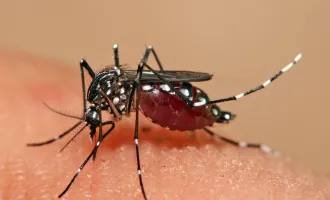
Is UCSF Prepared for a Decade of Darkness?
When UCSF staff member Lisa Magargal was notified that the power in her Rohnert Park home was to be shut off during one of PG&E’s planned power outages, she didn’t hesitate to act — she stocked up on battery-operated LED lights, canned food, and gas for her car.
Magargal, the administrative director of UCSF’s Graduate Medical Sciences Unit, has been here before. In 2017, the Pressley and Nuns fires burned in the Sonoma Mountains neighboring Rohnert Park, leading Magargal and her two cats to quickly find reprieve in a pet-friendly hotel in Morgan Hill.
This time, she was ready. PG&E had given her ample warning of the shutoff, so she was able to take mitigating actions.
When her power was turned off shortly after the outbreak of the Kincade fire in late October, she headed to Morgan Hill once more.
Magargal is one of thousands of UCSF community members and millions of Bay Area denizens impacted by PG&E’s Public Safety Power Shutoffs (PSPS) in recent months.
According to PG&E, the PSPS are preemptive measures enacted based on high wildfire-risk conditions such as Red Flag Warnings from the National Weather Service, humidity levels below 20 percent, and sustained winds above 25 mph.
In early October, PG&E turned off power to almost 800,000 Northern California residents, and by the end of the month was engaged in communication with their customers over premature outage cancellations and unforeseen extensions.
Fortunately, UCSF is prepared for the institution’s uncertain future with PG&E at the helm of its power supply.
Marjorie Smallwood, Director of Emergency Management for UCSF Health, confirmed that detailed emergency procedures for hospital power outages were established long before the PSPS.
She described the UCSF Health power supply as being a dual support system between PG&E supplying main power feeds and UCSF’s own central utilities plant at Parnassus Heights providing additional emergency power.
“If there was an unplanned power outage that impacted operations, we would immediately activate HICS — our hospital incident command system — with core leadership and staff to assess any potential impacts that may be seen or unseen,” Smallwood told Synapse.
“In terms of hospital infrastructure requirements across the country, which we fall under, we have emergency power capabilities beyond just the initial power support to support hospital healthcare operations for a minimum three to four days should we experience any power outages within the city and county of San Francisco.”
Such an unplanned outage occurred in early September at the UCSF Mission Bay campus. According to Smallwood, HICS was immediately activated and patient care was constantly monitored until the power returned to the offsite clinics more than three hours later.
As for the planned power outages, PG&E confirmed with UCSF emergency management that the level of wildfire risk in San Francisco is extremely low due to the lack of forests and trees that are more susceptible to wildfire, so PSPS should not directly affect the San Francisco area.
“PG&E’s wildfire state operations center — so their command and control center where they monitor wildfires across the whole state of California — is actually located in San Francisco,” Smallwood said.
Though PG&E has stated that its PSPS will not likely affect San Francisco proper, it is still having a considerable indirect impact on the UCSF community.
Alece Alderson, Assistant Vice Chancellor of Student Life at UCSF, said that she couldn’t break the habit of walking into a room in her Mill Valley home and trying to turn on the lights.
“As a society we are extremely reliant on electricity, so when we didn’t have power we were reminded of the impact,” Alderson told Synapse in an email. “Thankfully my husband is extremely proactive and we had everything we needed… except for ice. My sister lives in the East Bay and brought over 10 bags for the family.”
Fortunately, UCSF has been somewhat of a respite for students and employees affected by the outages. Magargal and Alderson both felt the weight of their worries at work, particularly because commuting to campus and communicating with colleagues was extremely difficult during the outage.
Alderson and her husband normally ride e-bikes to work, so with the power outage they had to charge their bikes at work and conserve battery power roundtrip.
Alderson was grateful that there was always food, electricity, and a hot shower available at her work gym.
During the outage, Magargal was concerned about her ability to communicate with others at work and with a sick family member living out of state.
Yet, Alderson and Magargal both had a sense of appreciation of their situations.
“At the end of the day, it was an inconvenience compared to people who were literally fighting fires forty-five minutes away from my house,” Alderson said.
“I feel lucky to have the means and ability to [evacuate],” Magargal said. “A lot of people don’t.”
UCSF also stepped in to help its North Bay affiliates evacuate during the Kincade fire. Smallwood stated that two hospitals had to be evacuated and that the Parnassus Heights Medical Center received about 20 adult patient transfers from North Bay.
In a recent statement, PG&E said it expects to hold more power shutoffs this week. And the future is not so promising as well.
Bill Johnson, the current CEO of PG&E, stated in early October that Californians will probably be experiencing outages for the next 10 years that would decrease in scope and frequency over time.
“As PG&E requires the next 10 years to really harden and protect their power infrastructure, these are going to be re-occurring events that we need to make sure we’re readily prepared for and instituting any lessons learned with each event,” Smallwood said.
“I do hope that PG&E is able to harden their infrastructure in a more timely fashion but my job is to prepare for the worst and hope for the best and that’s what we will continue to do.”
On Tuesday, Nov. 19, PG&E issued a statement on its website:
"Customers in portions of 25 counties have been notified about a potential Public Safety Power Shutoff starting Wednesday morning. Worsening dry conditions and expected high wind gusts pose an increased risk for damage and sparks on the electric system that have the potential to ignite fires in areas with dry vegetation.
"High fire-risk conditions are expected to begin early Wednesday morning and continue into Thursday. High winds are currently expected to subside Thursday mid-morning. PG&E will then inspect the de-energized lines to ensure they were not damaged during the wind event. PG&E will safely restore power in stages as quickly as possible, with the goal of restoring most customers by end of day Thursday, based on the current weather conditions.
"This afternoon, about 39,000 customers in portions of Santa Cruz, Santa Clara and San Mateo were notified that they might also be impacted by a PSPS – in addition to the 264,000 customers notified earlier today. The additional notifications were based on the changing weather forecast.
'While there is considerable uncertainty regarding the strength, timing and humidity levels associated with this weather system, the shutoff is currently expected to impact approximately 303,000 customers in 25 counties."



